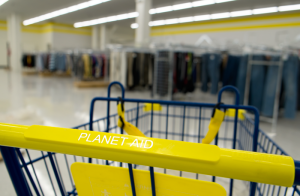Joining the Thrifting Movement
"I'm gonna pop some tags. Only got $20 in my pocket"
-Macklemore
"Thrifting" is no longer just for the thrifty.
Today about 20 percent of people shop in thrift stores regularly, up from 14 percent in 2008. With around 20,000 resale, consignment, and nonprofit shops currently operating in the United States, secondhand consumers have plenty of options to choose from.
The growth of the resale industry is likely due in part to a change in attitudes towards buying used. The Great Recession that began in 2009, which forced many people to adopt measures of frugality, may have helped frame thrift shopping as sensible rather than desperate, lessening any stigma surrounding it.
It also doesn't hurt that numerous celebrities, who certainly have no financial necessity to shop secondhand, sing the praises of thrift shopping. In rapper Macklemore's case this is literal singing, with his 2012 ode to the thrift shop espousing the virtues of "looking incredible in your granddad's clothes" over mainstream radio waves.
Thrift shopping complements larger social trends, as well. For those who want to lead eco-friendly lifestyles, buying secondhand is the most straightforward way to apply the virtues of recycling to fashion. The Do-It-Yourself, or "DIY," movement encourages resourcefulness instead of purchasing new. Thrift shops are natural allies of the DIY-er, serving as a valuable and affordable source for the materials needed for these projects.
And though the demand for secondhand outlets may have increased as a result of these cultural shifts, the supply of clothing to fill the racks is not necessarily dwindling as a result. Americans buy more clothes now than ever, in large part because fashion is so much cheaper today than in the past. The more we purchase, the faster we need to make room in our closets, increasing the amount of clothing we give away season to season.
 This "fast fashion" model sounds like a great idea, but it actually hurts our environment and the people who produce our clothes. In addition to purchasing retail responsibly, thrift shopping is a great antidote to this problem. Donating to and buying from thrift stores extends the life span of our clothes and keeps them out of the landfill. Plus, most thrift stores are not-for-profit, so purchasing items means supporting charitable work. Our thrift store in Maryland, the Planet Aid Thrift Center, supports our development projects abroad (as do the clothes dropped in our yellow bins throughout the country). Goodwill uses proceeds from its stores for job training. Salvation Army supports a wide range of domestic and international programs. There are also plenty of independent stores throughout the country that support their own local causes.
This "fast fashion" model sounds like a great idea, but it actually hurts our environment and the people who produce our clothes. In addition to purchasing retail responsibly, thrift shopping is a great antidote to this problem. Donating to and buying from thrift stores extends the life span of our clothes and keeps them out of the landfill. Plus, most thrift stores are not-for-profit, so purchasing items means supporting charitable work. Our thrift store in Maryland, the Planet Aid Thrift Center, supports our development projects abroad (as do the clothes dropped in our yellow bins throughout the country). Goodwill uses proceeds from its stores for job training. Salvation Army supports a wide range of domestic and international programs. There are also plenty of independent stores throughout the country that support their own local causes.
So grab a couple bucks, go forth and, in the wise words of Macklemore, "pop some tags" at your local thrift store.
The Planet Aid Thrift Center, our first large retail store, opens in Baltimore, Maryland on October 1. Learn more about the store here.

Read about the Planet Aid Thrift Center in the Baltimore Sun.
